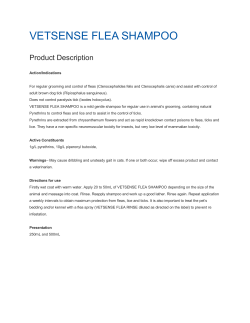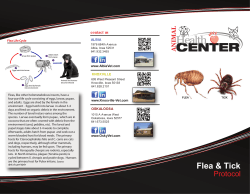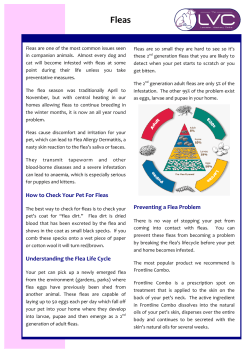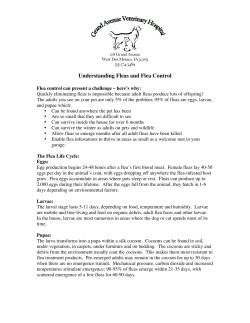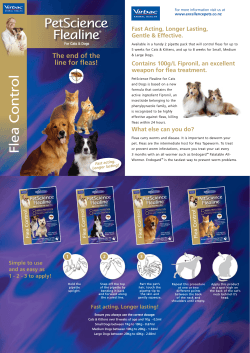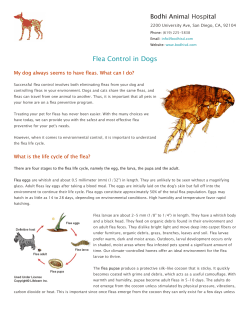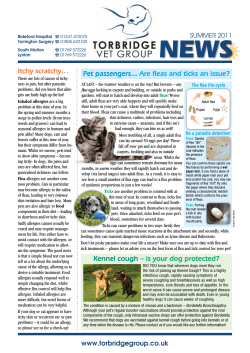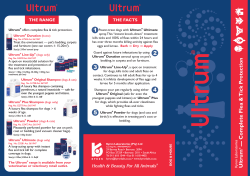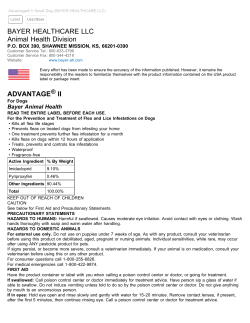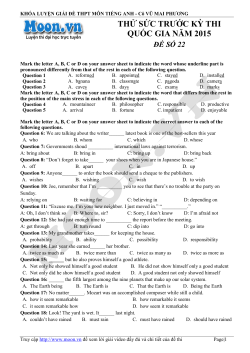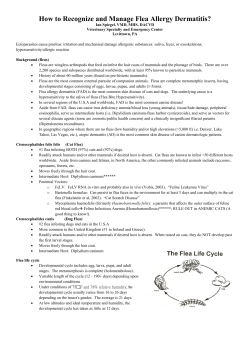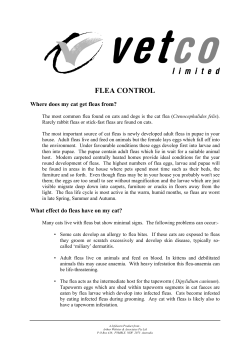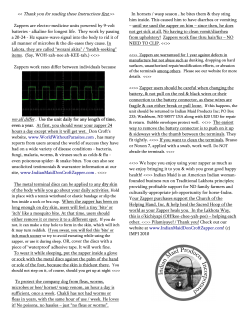
T OFF YOUR PETS AND OUT OF YOUR YARD KEEPING
LESS-TOXIC PEST MANAGEMENT KEEPING FLEAS OFF YOUR PETS AND OUT OF YOUR YARD LESS-TOXIC CONTROLS INSIDE YOUR HOME T he flea most commonly found in and around the home is the cat flea, Ctenocephalides felis. Despite its name, the cat flea fi nds dogs and humans quite tasty too. Flea bites cause irritation, but also serious allergies in some animals and humans. DETECTION Adult fleas spend almost all of their time on an animal’s body. Look for tiny, white, worm-like flea larvae on the floor, in rugs, in cracks and crevices, and anywhere pets rest or sleep. They feed on dried blood excreted by adult fleas. In order to know when to begin and end your flea-control efforts, use a specially manufactured flea comb on your pet to keep track of the flea population. Activity increases when temperatures are warm. • Comb your pet with a metal flea comb, available at pet stores. Focus around the neck and base of the tail. Keep a wide container of soapy water nearby to drown captured fleas. • Bathe dogs in soap and water to drown fleas. Increase effectiveness by using a flea comb while the pet is lathered. It is not necessary to use soap with insecticide. • Vacuum carpets, floors, and upholstered furniture frequently throughout the year. Vacuuming carpets picks up adult and egg-stage fleas, but is less effective at removing larvae. Clean cracks and crevices; or better still, seal permanently with caulk. • Use diatomaceous earth (DE) to treat carpets, upholstered furniture, and pet bedding or blow it into cracks and crevices. Use a hand duster to apply a fi ne layer of DE. Wear a dust mask and goggles and avoid getting dust in your pet’s eyes. DE has little toxicity to humans and pets, but kills fleas by absorbing the waxy coating on their bodies, causing dehydration and death. Use DE sold for pest control and gardening, not for swimming pool fi lters. PROVIDED BY THE CITIES AND COUNTY OF VENTURA • 805/289-3333 • Use borate-based carpet treatments. Borates have a low toxicity to humans and pets. Fleanix® carpet treatment can control fleas in carpeting for up to a year. Mix the powder with water in a rug shampooing machine with or without detergent. During shampooing, borate binds to carpet fibers and cannot be vacuumed up. • Flea traps can help you confirm an infestation if you don’t own a pet but still have fleas. Also check for wild animals or rodents nesting in or around your home. Adult fleas are attracted to the warmth and light of an electric bulb and are caught on sticky paper. The most effective traps have a flickering green light. • Insect growth regulators (IGRs) prevent flea eggs from hatching and inhibit larvae from developing. The IGR methoprene can be applied to areas such as carpets and pet bedding. IGRs will not kill fleas that have reached adulthood before the material is applied. Use IGRs in combination with other measures listed in this fact sheet. Some products combine methoprene with permethrin to control both pre-adult and adult fleas. 1/03 OUTSIDE YOUR HOME FOR YOUR ANIMAL • Treat outside only where you have found high flea populations. To find these areas, walk around the yard and lawn in a pair of white socks. Check areas where animals rest, sleep, or regularly travel. You will easily see fleas that jump onto the socks. • Do not try to combat fleas by spraying around the perimeter of your house or spraying your entire yard. Spot-treat only those areas where you find large populations of fleas. Fleas will more likely be on an animal or inside your home. Concentrate your efforts there. • Check for animals like raccoons and opossums living under the house. Dead animals can also be a source of fleas. Call animal control specialists for help. Seal access while animals are away. • Use beneficial nematodes in soil where you have found fleas. Be sure to water the area before and after application. For sources of nematodes, see the Products and Resources box. • Ultrasonic collars and machines are not effective. There is no scientific evidence that these products affect fleas, and they are not recommended. • Fipronil (Frontline®) and imidacloprid (Advantage®) are applied to the skin of the animal in a small amount at one spot, usually at the base of the neck or between the shoulder blades. The insecticide spreads over the entire body of the pet and is effective for at least a month. These products have a low acute toxicity for mammals but can be irritating to eyes and should not be ingested. Use rubber gloves when applying them. • Lufenuron (Program®) is given orally to the animal. Fleas that ingest this chemical produce only a few viable eggs, and larvae from those eggs cannot mature. Because lufenuron accumulates in fat and crosses the placental barrier, do not treat pregnant, nursing, or very young animals. PRODUCTS AND RESOURCES Examples of trade names of products listed in this fact sheet: Insecticidal Dusts: Surefi re® Crawling Insect Killer Hand Duster: Pest Pistol® Borate-based Carpet Treatments: Fleanix® Flea Trap: The Ultimate Flea Trap (Victor) ® Pest No More® Flea Trap Insect Growth Regulators (IGRs): Precor® On Your Animal: Frontline® (Fipronil), Advantage® (Imidacloprid) Ingested by Your Animal (available from vets): Program® (Lufenuron) Beneficial Nematodes: Steinernema carpocapse. Rincon Vitova, P.O. 1555, Ventura, CA 93002; 805/643-5407 Tip Top Bio-Control, P.O. Box 7614, Thousand Oaks, CA 91359; 805/445-9001. www.tiptopbio.com THE COUNTY OF VENTURA ENVIRONMENTAL AND ENERGY RESOURCES DEPARTMENT DOES NOT ENDORSE ANY ORGANIZATIONS OR VENDORS NOR ASSUME ANY LIABILITY FOR INFORMATION LISTED IN THIS FACT SHEET. PESTICIDES & WATER POLLUTION Pesticides can damage our health and kill beneficial insects necessary for a healthy garden. Common household pesticides show up in our waterways, sometimes at levels that can harm sensitive aquatic life. The County of Ventura Environmental and Energy Resources Department is working with local nurseries and hardware stores to reduce the risks associated with pesticide use. This fact sheet is part of a series of informative publications and store displays designed to educate Ventura County residents about less-toxic pest management. Look for the “Our Water Our World” logo next to products in participating nurseries and hardware stores thoughout Ventura County. For a list of participating stores, call 805/289-3333 or visit http://www.wasteless.org Pest control strategies and methods described in these publications are consistent with Integrated Pest Management (IMP) concepts, and are based on scientific studies and tests in actual home and garden settings. IPM is an environmentally sound approach to pest management combining various methods with good horticultural practices. Follow all label directions on any suggested products. NO endorsement of specific brand name product is intended, nor is criticism implied of similar products not mentioned. Different products with the same active ingredients are equally suitable. HOUSEHOLD HAZARDOUS WASTE COLLECTION PROGRAMS Most cities offer FREE monthly collection events that accept pesticides, fertilizers, latex and oil based paint, motor oil and filters, car and household batteries, pool chemicals, stains, solvents, fluorescent light tubes, automotive fluids, cleaning products, photographic chemicals and more. For more information and collection schedules call 805/289-3333 or visit www.wasteless.org. FOR MORE INFORMATION Participating stores have been provided books on Integrated Pest Management (IPM) you may use while in the store. The store staff has been extensively trained in IPM to assist you. The Certified Master Gardener Program operated by the University of California Cooperative Extension provides a free assistance Helpline and offers a variety of workshops and school education programs. Call 805/645-1455. Check these websites: http://www. watoxics.org http://www.ipm.ucdavis.edu http://www.pesticide.org/factsheets.html ACKNOWLEDGEMENTS This fact sheet was originally developed by the Central Contra Costa Sanitary District. Research and modifications for Ventura County were provided by Deborah Mills, Green Cure, Inc. SW5338-IMP pubs 1/03(18)
© Copyright 2025
